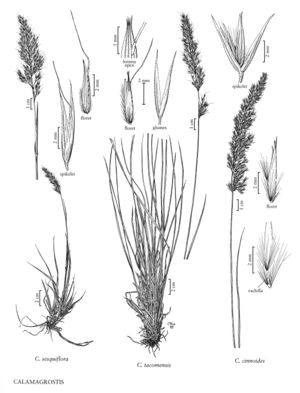Calamagrostis tacomensis
Plants without sterile culms; cespitose, sometimes densely so, usually without rhizomes, sometimes with rhizomes about 2 cm long, 2-3 mm thick. Culms (20)30-55(95) cm, unbranched, smooth or slightly scabrous beneath the panicles; nodes (1)2(5). Sheaths and collars smooth or slightly scabrous; ligules (3)3.5-5.5(6) mm, usually truncate to obtuse, usually entire, sometimes lacerate; blades (6)7-14(30) cm long, (1.5)2-2.5(4) mm wide, flat, abaxial surfaces usually smooth, rarely slightly scabrous, adaxial surfaces usually slightly scabrous, rarely smooth, glabrous or sparsely hairy. Panicles (5)7-10(18) cm long, (0.5)1-2(3) cm wide, loosely contracted, sometimes open, erect to slightly nodding, shiny green and purple; branches (2)2.3-4(6) cm, scabrous, usually spikelet-bearing on the distal 2/3, sometimes to the base. Spikelets (4)6-6.5(7) mm; rachilla prolongations 1.5-2(2.5) mm, hairs (1.5)2(3) mm. Glumes often green with a purple patch at the base, keeled, keels smooth or sparsely scabrous on the distal 1/2, lateral veins usually prominent, apices usually acute, sometimes short-acuminate, not twisted; callus hairs (1.2)2(2.5) mm, (0.3)0.4-0.5(0.6) times as long as the lemmas, abundant; lemmas (3.5)4-5(5.5) mm, (0.5)1.5-2(3) mm shorter than the glumes; awns (5.5)7-8.5(10) mm, attached to the lower 1/10-1/3 of the lemmas, exserted more than 2 mm, easily distinguished from the callus hairs, strongly bent; anthers (1)2-3(3.5) mm. 2n = unknown.
Discussion
Calamagrostis tacomensis grows on montane to alpine slopes in dry or wet meadows, seeps, rocky talus slopes, and cliff crevices, at 400-2200 m. It grows only in the mountains of western Washington and in the Steens Mountains of southeastern Oregon. It reaches its highest known elevations in the Steens Mountains.
This species has previously been identified as either Calamagrostis purpurascens (p. 710) (C.L. Hitchcock et al. 1969) or C. sesquiflora (p. 714) (Kawano 1965). It differs from C. purpurascens in having glabrous leaves, generally longer awns and inflorescence branches, and smoother glumes. It differs from C. sesquiflora in having narrower leaves, callus hairs that are longer relative to the lemmas, longer inflorescence branches, and glume apices that are not twisted, as well as in often preferring drier habitats.
Selected References
None.
